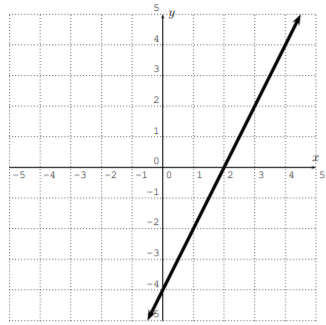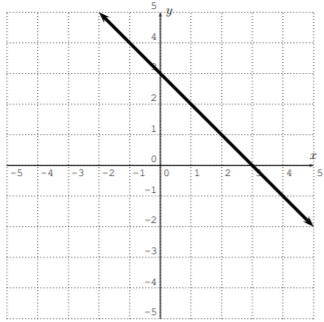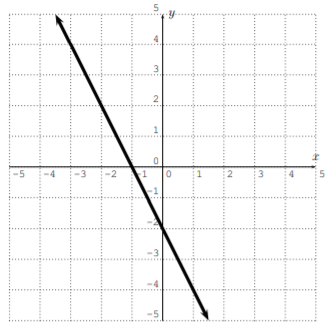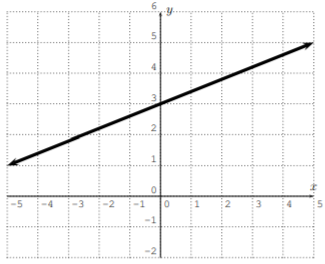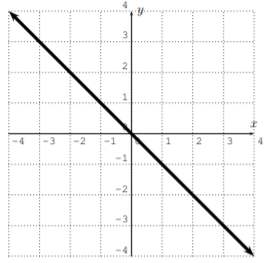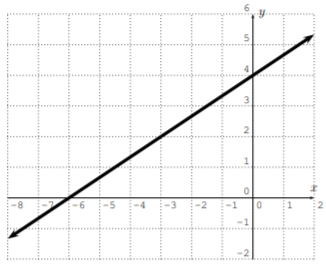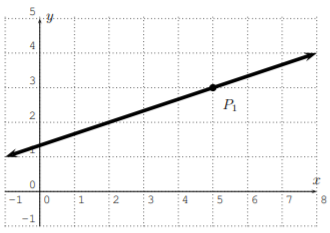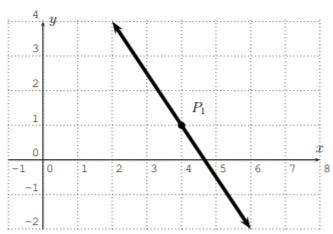2.3: Exercises
- Page ID
- 48956
\( \newcommand{\vecs}[1]{\overset { \scriptstyle \rightharpoonup} {\mathbf{#1}} } \)
\( \newcommand{\vecd}[1]{\overset{-\!-\!\rightharpoonup}{\vphantom{a}\smash {#1}}} \)
\( \newcommand{\dsum}{\displaystyle\sum\limits} \)
\( \newcommand{\dint}{\displaystyle\int\limits} \)
\( \newcommand{\dlim}{\displaystyle\lim\limits} \)
\( \newcommand{\id}{\mathrm{id}}\) \( \newcommand{\Span}{\mathrm{span}}\)
( \newcommand{\kernel}{\mathrm{null}\,}\) \( \newcommand{\range}{\mathrm{range}\,}\)
\( \newcommand{\RealPart}{\mathrm{Re}}\) \( \newcommand{\ImaginaryPart}{\mathrm{Im}}\)
\( \newcommand{\Argument}{\mathrm{Arg}}\) \( \newcommand{\norm}[1]{\| #1 \|}\)
\( \newcommand{\inner}[2]{\langle #1, #2 \rangle}\)
\( \newcommand{\Span}{\mathrm{span}}\)
\( \newcommand{\id}{\mathrm{id}}\)
\( \newcommand{\Span}{\mathrm{span}}\)
\( \newcommand{\kernel}{\mathrm{null}\,}\)
\( \newcommand{\range}{\mathrm{range}\,}\)
\( \newcommand{\RealPart}{\mathrm{Re}}\)
\( \newcommand{\ImaginaryPart}{\mathrm{Im}}\)
\( \newcommand{\Argument}{\mathrm{Arg}}\)
\( \newcommand{\norm}[1]{\| #1 \|}\)
\( \newcommand{\inner}[2]{\langle #1, #2 \rangle}\)
\( \newcommand{\Span}{\mathrm{span}}\) \( \newcommand{\AA}{\unicode[.8,0]{x212B}}\)
\( \newcommand{\vectorA}[1]{\vec{#1}} % arrow\)
\( \newcommand{\vectorAt}[1]{\vec{\text{#1}}} % arrow\)
\( \newcommand{\vectorB}[1]{\overset { \scriptstyle \rightharpoonup} {\mathbf{#1}} } \)
\( \newcommand{\vectorC}[1]{\textbf{#1}} \)
\( \newcommand{\vectorD}[1]{\overrightarrow{#1}} \)
\( \newcommand{\vectorDt}[1]{\overrightarrow{\text{#1}}} \)
\( \newcommand{\vectE}[1]{\overset{-\!-\!\rightharpoonup}{\vphantom{a}\smash{\mathbf {#1}}}} \)
\( \newcommand{\vecs}[1]{\overset { \scriptstyle \rightharpoonup} {\mathbf{#1}} } \)
\( \newcommand{\vecd}[1]{\overset{-\!-\!\rightharpoonup}{\vphantom{a}\smash {#1}}} \)
\(\newcommand{\avec}{\mathbf a}\) \(\newcommand{\bvec}{\mathbf b}\) \(\newcommand{\cvec}{\mathbf c}\) \(\newcommand{\dvec}{\mathbf d}\) \(\newcommand{\dtil}{\widetilde{\mathbf d}}\) \(\newcommand{\evec}{\mathbf e}\) \(\newcommand{\fvec}{\mathbf f}\) \(\newcommand{\nvec}{\mathbf n}\) \(\newcommand{\pvec}{\mathbf p}\) \(\newcommand{\qvec}{\mathbf q}\) \(\newcommand{\svec}{\mathbf s}\) \(\newcommand{\tvec}{\mathbf t}\) \(\newcommand{\uvec}{\mathbf u}\) \(\newcommand{\vvec}{\mathbf v}\) \(\newcommand{\wvec}{\mathbf w}\) \(\newcommand{\xvec}{\mathbf x}\) \(\newcommand{\yvec}{\mathbf y}\) \(\newcommand{\zvec}{\mathbf z}\) \(\newcommand{\rvec}{\mathbf r}\) \(\newcommand{\mvec}{\mathbf m}\) \(\newcommand{\zerovec}{\mathbf 0}\) \(\newcommand{\onevec}{\mathbf 1}\) \(\newcommand{\real}{\mathbb R}\) \(\newcommand{\twovec}[2]{\left[\begin{array}{r}#1 \\ #2 \end{array}\right]}\) \(\newcommand{\ctwovec}[2]{\left[\begin{array}{c}#1 \\ #2 \end{array}\right]}\) \(\newcommand{\threevec}[3]{\left[\begin{array}{r}#1 \\ #2 \\ #3 \end{array}\right]}\) \(\newcommand{\cthreevec}[3]{\left[\begin{array}{c}#1 \\ #2 \\ #3 \end{array}\right]}\) \(\newcommand{\fourvec}[4]{\left[\begin{array}{r}#1 \\ #2 \\ #3 \\ #4 \end{array}\right]}\) \(\newcommand{\cfourvec}[4]{\left[\begin{array}{c}#1 \\ #2 \\ #3 \\ #4 \end{array}\right]}\) \(\newcommand{\fivevec}[5]{\left[\begin{array}{r}#1 \\ #2 \\ #3 \\ #4 \\ #5 \\ \end{array}\right]}\) \(\newcommand{\cfivevec}[5]{\left[\begin{array}{c}#1 \\ #2 \\ #3 \\ #4 \\ #5 \\ \end{array}\right]}\) \(\newcommand{\mattwo}[4]{\left[\begin{array}{rr}#1 \amp #2 \\ #3 \amp #4 \\ \end{array}\right]}\) \(\newcommand{\laspan}[1]{\text{Span}\{#1\}}\) \(\newcommand{\bcal}{\cal B}\) \(\newcommand{\ccal}{\cal C}\) \(\newcommand{\scal}{\cal S}\) \(\newcommand{\wcal}{\cal W}\) \(\newcommand{\ecal}{\cal E}\) \(\newcommand{\coords}[2]{\left\{#1\right\}_{#2}}\) \(\newcommand{\gray}[1]{\color{gray}{#1}}\) \(\newcommand{\lgray}[1]{\color{lightgray}{#1}}\) \(\newcommand{\rank}{\operatorname{rank}}\) \(\newcommand{\row}{\text{Row}}\) \(\newcommand{\col}{\text{Col}}\) \(\renewcommand{\row}{\text{Row}}\) \(\newcommand{\nul}{\text{Nul}}\) \(\newcommand{\var}{\text{Var}}\) \(\newcommand{\corr}{\text{corr}}\) \(\newcommand{\len}[1]{\left|#1\right|}\) \(\newcommand{\bbar}{\overline{\bvec}}\) \(\newcommand{\bhat}{\widehat{\bvec}}\) \(\newcommand{\bperp}{\bvec^\perp}\) \(\newcommand{\xhat}{\widehat{\xvec}}\) \(\newcommand{\vhat}{\widehat{\vvec}}\) \(\newcommand{\uhat}{\widehat{\uvec}}\) \(\newcommand{\what}{\widehat{\wvec}}\) \(\newcommand{\Sighat}{\widehat{\Sigma}}\) \(\newcommand{\lt}{<}\) \(\newcommand{\gt}{>}\) \(\newcommand{\amp}{&}\) \(\definecolor{fillinmathshade}{gray}{0.9}\)Find the slope and \(y\)-intercept of the line with the given data. Using the slope and \(y\)-intercept, write the equation of the line in slope-intercept form.
- Answer
-
- \(y=2 x-4\)
- \(y=-x+3\)
- \(y=-2 x-2\)
- \(y=\dfrac{2}{5} x+3\)
- \(y=-x+0\) or\( y=-x\)
- \(y=\dfrac{2}{3} x+4\)
Write the equation of the line in slope-intercept form. Identify slope and \(y\)-intercept of the line.
- \(4x+2y=8\)
- \(9x-3y+15=0\)
- \(-5x-10y=20\)
- \(3x-5y=7\)
- \(-12x+8y=-60\)
- \(8x-9y=0\)
- Answer
-
- \(y=-2 x+4\)
- \(y=3 x+5\)
- \(y=-\dfrac{1}{2} x-2\)
- \(y=\dfrac{3}{5} x-\dfrac{7}{5}\)
- \(y=\dfrac{3}{2} x-\dfrac{15}{2}\)
- \(y=\dfrac{8}{9} x\)
Find the equation of the line in point-slope form (Eq. 2.1.2) using the indicated point \(P_1\).
- Answer
-
- \(y-3=\dfrac{1}{3} \cdot(x-5)\)
- \(y-1=-\dfrac{3}{2} \cdot(x-4)\)
- \(y+2=-\dfrac{1}{2} \cdot(x-3)\)
- \(y-1=1 \cdot(x+1)\)
Graph the line by calculating a table (as in Example 2.1.1). (Solve for \(y\) first, if this is necessary.)
- \(y=2x-4\)
- \(y=-x+4\)
- \(y=\dfrac 1 2 x +1\)
- \(y=3x\)
- \(8x-4y=12\)
- \(x+3y+6=0\)
- Answer
-
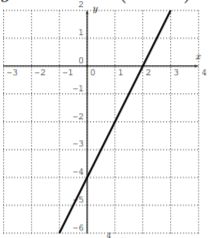
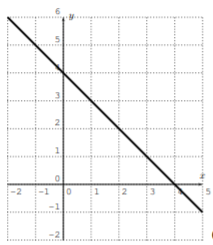
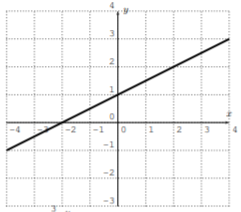
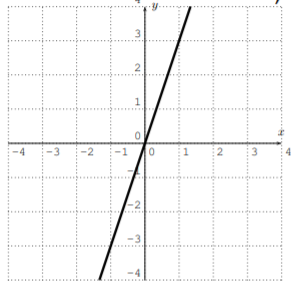
- \(y=2 x-3\)
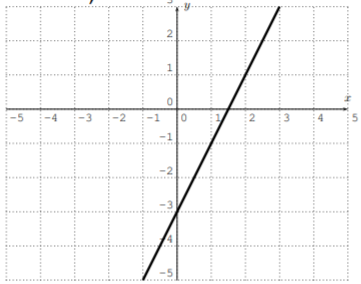
- \(y=-\dfrac{1}{3} x-2\)
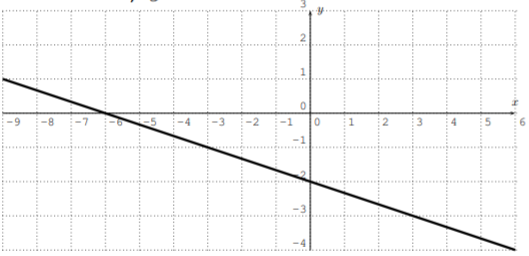
Determine if the given table describes a function. If so, determine its domain and range. Describe which outputs are assigned to which inputs.
- \[\begin{array}{|c||c|c|c|c|c|}
\hline x & -5 & 3 & -1 & 6 & 0 \\
\hline \hline y & 5 & 2 & 8 & 3 & 7 \\
\hline
\end{array} \nonumber \] - \[\begin{array}{|c||c|c|c|c|c|}
\hline x & 6 & 17 & 4 & -2 & 4 \\
\hline \hline y & 8 & -2 & 0 & 3 & -1 \\
\hline
\end{array} \nonumber \] - \[\begin{array}{|c||c|c|c|c|c|c|}
\hline x & 19 & 7 & 6 & -2 & 3 & -11 \\
\hline \hline y & 3 & 3 & 3 & 3 & 3 & 3 \\
\hline
\end{array} \nonumber \] - \[\begin{array}{|c||c|c|c|c|c|c|}
\hline x & 1 & 2 & 3 & 3 & 4 & 5 \\
\hline \hline y & 5.33 & 9 & 13 & 13 & 17 & \sqrt{19} \\
\hline
\end{array} \nonumber \] - \[\begin{array}{|c||c|c|c|c|c|c|}
\hline x & 0 & 1 & 2 & 2 & 3 & 4 \\
\hline \hline y & 0 & 1 & 2 & 3 & 3 & 4 \\
\hline
\end{array} \nonumber \]
- Answer
-
- this is a function with domain \(D=\{-5,-1,0,3,6\}\) and range \(R = \{2, 3, 5, 7, 8\}\), for example: the input \(x = −5\) gives output \(y = 5\), etc.
- not a function since for \(x = 4\) we have both \(y = 0\) and \(y = −1\)
- this is a function with \(D = \{−11, −2, 3, 6, 7, 19\}\), \(R = \{3\}\)
- this is a function with \(D=\{1,2,3,4,5\}, R=\{\sqrt{19}, 5.33,9,13,17\}\)
- this is not a function
We consider children and their (birth) mothers.
- Does the assignment child to their birth mother constitute a function (in the sense of Definition as stated here)?
- Does the assignment mother to their children constitute a function?
- In the case where the assignment is a function, what is the domain?
- In the case where the assignment is a function, what is the range?
- Answer
-
- yes
- no
- the domain for the function in (a) is the set of all children
- the range for the function in (a) is the set of all mothers
A bank offers wealthy customers a certain amount of interest, if they keep more than \(1\) million dollars in their account. The amount is described in the following table:
\[\begin{array}{|c||c|}
\hline \text { dollar amount } x \text { in the account } & \text { interest amount } \\
\hline \hline x \leq \$ 1,000,000 & \$ 0 \\
\hline \$ 1,000,000<x \leq \$ 10,000,000 & 2 \% \text { of } x \\
\hline \$ 10,000,000<x & 1 \% \text { of } x \\
\hline
\end{array} \nonumber \]
- Justify that the assignment cash amount to interest defines a function.
- Find the interest for an amount of:
- \(\$50,000\)
- \(\$5,000,000\)
- \(\$1,000,000\)
- \(\$30,000,000\)
- \(\$10,000,000\)
- \(\$2,000,000\)
- Answer
-
- a given cash amount \(x\) determines the interest amount \(y\)
- i) \(\$0\), ii) \(\$100,000\), iii) \(\$0\), iv) \(\$300,000\), v) \(\$200,000\), vi) \(\$40,000\)
Find a formula for a function describing the given inputs and outputs.
- input: the radius of a circle, output: the circumference of the circle
- input: the side length in an equilateral triangle, output: the perimeter of the triangle
- input: one side length of a rectangle, with other side length being \(3\), output: the perimeter of the rectangle
- input: the side length of a cube, output: the volume of the cube
- Answer
-
- \(C=2 \pi r\)
- \(P=3 a\)
- \(P=2 a+6\)
- \(V=a^{3}\)



